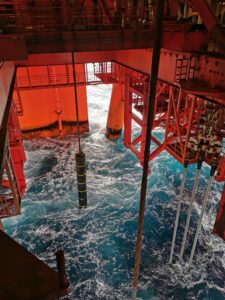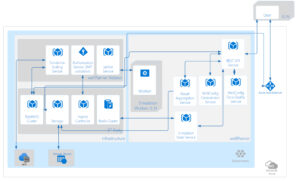Smart cloud-based tools take digital well planning to next level
New systems focus on freeing data from silos and providing real-time contextualization, visualization capabilities so data is instantly actionable
By Stephen Whitfield, Associate Editor
In a typical well planning cycle, an engineer will spend a significant portion of their time looking for the different types of data they need in order to do their jobs efficiently. Instead of being easily accessible in one location, these data tend to be locked away in silos – trajectories in one data platform, risk and hazards in another, well construction documents in another and so forth.

Locating the specific data needed can also be cumbersome due to access restrictions. For example, a company’s drilling engineers may not have access to the applications and systems used by its geologists. Something as simple as a limit on the number of users can also be another obstacle that users have to overcome when tracking down data.
Fortunately, the well planning process is evolving rapidly. New cloud-based systems are now helping organizations to improve the communication, integration and automation of data flows between data managers and users. Data can be extracted from different sources onto a single platform and contextualized. This not only makes it easier for subject matter experts across an organization to access the data but also ensures the data is accurate. The result is better collaboration between the various teams involved in planning new wells.
“When collaboration becomes easier, insights and decisions become quicker,” said Kaveh Pourteymour, CIO at Neptune Energy. “We want to provide better access and make it easier to search for data, leveraging the power of the cloud. This is all part of our overall agenda to not just do things faster but better.”
Streamlined workflows
Over the past year, Neptune, one of the largest independent E&P companies in Europe, has been in the midst of a major digital transformation. Among other things, the goal of its digital subsurface program, launched in 2020, is to better organize data and streamline well planning. The operator is aiming to cut the time to discover hydrocarbons, reduce exploration costs and bring discoveries into production earlier than industry standards.
As part of the program, Neptune adopted Halliburton’s DecisionSpace365 well construction suite of cloud applications late last year to consolidate all of its global drilling and wells activities. The applications run from Halliburton’s iEnergy Hybrid Cloud system, which acts as the central repository for Neptune’s drilling and wells data. Through this technology adoption, Neptune aims to eventually reduce the time needed for well planning from weeks to days, automate engineering calculations, and consolidate data currently held across multiple locations around the world onto a single platform.
Neptune sees DecisionSpace365 as the foundation on which it can explore other digital opportunities to streamline data analysis. The system offers four applications specifically designed for well planning: one for customizing well construction programs, one for creating a digital twin of the wellbore and monitoring well activities, one for developing automated workflows to adjust planning activity based on field conditions, and one for providing real-time alerts of potential problems from the field during well construction.
Being able to visualize data as it is processed is a major benefit, Mr Pourteymour said. The platform standardizes geophysical, geological and real-time drilling data into one-, two- and three-dimensional environments, as well as a repository of common exploration workflows and company-specific best practices. Previously, this information was stored across four separate legacy systems. Now, with all the data more easily accessible, personnel can focus more on the decision-making process.
“Translating raw data into good visualizations allows for better and improved decisions,” Mr Pourteymour said. “This is going to feed our digital twins, and it’s going to give us a very comprehensive business intelligence data platform.”
DecisionSpace will be used to house wells master data as part of Neptune’s digital strategy, which enables the company to break down key information about well components, such as casing and tubing strings, into digital objects, said Brett McIntyre, Neptune’s Head of Drilling and Wells.

The initial implementation and data migration involved shifting four separate on-premise databases into the DecisionSpace cloud platform. Neptune also plans to digitize and migrate relevant legacy well information contained in paper-based files going back many decades into DecisionSpace.
“You’re standardizing on one system for tasks traditionally spread across separate systems, like well schematics, well reports and nonproductive time analysis, and creating a platform to work digitally across disciplines, as well as reducing duplication,” he added. “This even helps to digitize well activities like plug and abandonment planning, where you are evaluating well barriers against permeable formations behind pipe and where the well has been cemented when originally drilled.”
While the integration of all data sources is still ongoing, Mr McIntyre said Neptune has seen some early results. The operator has already placed all of its drilling operations onto the cloud system. This has enabled greater standardization, which in turn has allowed its drilling and wells teams to better identify similarities between wells in different parts of the world. Various teams at Neptune have also adopted new workflows into their well planning processes based on the lessons learned from the data analysis.
Beyond DecisionSpace, in May this year, Neptune launched digital dashboards that allow users to compare drilling and wells data with other aspects of Neptune’s business, including production, supply chain, safety and financial data. The dashboards essentially act as a means to visualize data processed from Neptune’s data warehouse platforms, which were designed on the Microsoft Power BI system.
Mr Pourteymour described the platform as a data mesh system. Unlike a traditional data infrastructure, which handles data consumption, storage and output within a single repository, the system supports distributed, domain-specific data streams connected by an interoperability layer that standardizes data syntax. The standardization makes it easier to compare data from different sources.
Enabling access to data from different business units allows personnel to better understand how the risks present in a given operation can affect the entire company, Mr Pourteymour said. This can impact the identification of safety risks.
“Wide-ranging data are being fed into our advanced analytics engine and our dashboards, so we’re actually creating quite sophisticated trending of our individual safety and process safety,” he continued. “It’s basically putting together a more complete picture. The learnings being made in HSSE will be useful for well drilling or for production. We are also applying advanced analytics to our risk management processes, and the BI system gives us a comprehensive capability to better manage risks in all parts of our business.”
Contextualizing data
Since its founding in 2017, Cognite, an industrial AI software-as-a-service company, has focused on contextualizing data for asset-intensive industries like manufacturing and power utilities. Recently, the company has turned its attention to oil and gas drilling.
Historically, companies had to access multiple data sources to view previously drilled wells and run analyses. The Cognite Data Fusion (CDF) platform streamlines that process and contextualizes data about these wells, meaning that it adds related information to existing data to help users better identify patterns, trends and correlations to make it actionable. CDF is a back-end system, so users can build additional applications on top of it and stream the contextualized data within CDF for different functions within a well’s operation, including well construction.
“The objective of Cognite Data Fusion is to liberate the data from the silos and make it available for bigger, faster and more efficient consumption,” said Javier Leal, Product Manager for Drilling and Wells at Cognite. “We’re making it available within a shared environment so that it can be exploited in multiple ways. It could be something as simple as placing it in a dashboard to give people an effective assessment of an operation’s progress, or it could be something as complex as full-blown data science, modeling particular problems.”
The platform works through a combination of machine learning, natural language processing (NLP), rules engines and subject matter expert analysis. Contextualization is a two-step approach. First, mentions of particular wells within given documents, reports and spreadsheets are detected and categorized according to a set of rules established by the user. Users also provide feedback on the detection and organization of each mention, thereby growing the training dataset for a machine learning model performing named entity recognition. Named entity recognition is an application of NLP in which key information, like the name of an asset or a location, is automatically identified and classified into predefined categories.
In the second step of contextualization, mentions of assets detected through the machine learning model are used to relate available data resources for a given asset. This can include a wellbore trajectory or the time series of downhole sensor measurements to the document content via the asset’s unique identifier.
By entering keywords in a search engine or drawing a polygon on a map, an engineer can search previously drilled wells and all the contextualized data associated with them, such as well schematics and well header data from the company’s data warehouse, casing section information, formation tops, and historical drilling data. The combination of applications allows for full integration of well planning and operations, reducing decision-making time.
CDF’s first application within the oil and gas industry came in 2019 when it was incorporated into Aker BP’s open and standardized digital drilling ecosystem. The platform was used to contextualize things like sensor data, work orders, piping and instrumentation diagrams, subsurface and well data. The operator then used that data within its digital drilling ecosystem to create a digital representation of multiple projects.
Aker BP is also using CDF to contextualize a variety of well information to help predict the onset of chalk influx events over the lifecycle of the well. Sensor data from historical wells, such as bottomhole pressure and temperature, wellhead temperature and the transfer of solids, are contextualized in the system and then streamed into a chalk influx “dashboard.”
The models running in the dashboard compare data from the well being drilled with historical data to detect anomalies in the time series. If detected, the models communicate with each other and send a signal to support personnel on the rig, who can then commence mitigating actions to prevent deferrals in the wells.
Aker BP has also partnered with Cognite on other digital initiatives. In November 2020, the two companies announced a jointly developed framework for configurable document processing that makes raw data searchable by leveraging existing cloud-based services, such as NLP and application programming interfaces (APIs). An API is a set of functions and procedures that allow for the creation of applications that access data.
Raw data is extracted and contextualized to related assets based on keywords and geospatial location. Machine learning categorization supports file grouping into document types, such as a well plan. These contextualization capabilities make this search different from a typical enterprise search installation because it relates the searched content to the associated structured data.
A combination of machine learning methodology and user feedback categorizes documents into types, such as daily drilling reports, scientific papers and geological reports. As part of the ingestion pipeline, documents are tokenized, and the relative frequencies of particular terms are used as inputs for a machine learning classifier, providing a document type. When inspecting the search results returned by a query, the user can provide feedback on the predicted class of each document.
Cognite says it has made documents available for search within both human-made and machine-made folder systems. The content extracted from well reports provide information about historical issues that happened to offset wells, which can support the planning of new wells in the same area under similar circumstances.
The document search system has been rolled out to more than 500 subject matter experts among Aker BP’s drilling and wells, exploration, and reservoir development departments. During the testing phase, which concluded last year, users reported significant savings in the number of hours spent searching for data. They also reported greater access to data than expected, as well as more frequent exchanges of information about the reliability of the data discovered.
Customized well planning
eDrilling, a supplier of AI, machine learning and predictive analytics systems for drilling operations, has been creating digital systems to improve well planning since its founding in 2008. Its wellPlanner software, launched in 2013, provides advanced simulations to help operators or service companies in well planning and well optimization.

In December 2020, eDrilling announced that it would offer wellPlanner as an OpenAPI based on a microservice architecture, or small, independent applications that perform a specific service for a larger application. Each microservice takes specific capabilities within the full wellPlanner software and makes them available as individual applications that can be integrated into a company’s existing infrastructure or engineering tools.
The microservices are offered as two modules. The first covers dynamic simulations for hydraulics and temperature, which include multiphase flow, static and dynamic density, pressure and flow, temperature, fluid rheology, frictional pressure loss, cuttings load and transport in the annulus.
The other microservice covers torque and drag, which includes weight on bit from hookload, torque on bit from surface torque, axial and rotational friction factors, bit depth corrections due to string elasticity, buoyancy, well depth, rotational speed and block speed, and drag forces.
Kenza Lahlou, Chief Customer Success Officer at eDrilling, said the wellPlanner microservices can complement an operator’s existing in-house programs to expedite the planning process and reduce risks and uncertainties in the planning with accurate simulations.
“Let’s say a company has everything they want for their well planning, but they don’t have the best hydraulic model. You can basically use our dynamic hydraulic and temperature microservice to get the results you need without having to replace your current system. Anyone who wants to have only that module can integrate it into their engineering tool,” Ms Lahlou said.
TotalEnergies was the first operator to adopt the wellPlanner microservices within its engineering platform. In April 2020, the operator announced that it would incorporate the microservices within the Total Drilling Engineering Software Kit and would be used in front-end engineering and design for its wells.
Coding for the dynamic hydraulic and temperature microservice was completed in late 2020, and TotalEnergies made this service available on a limited scope on 1 December. By February 2021, coding on the torque and drag microservice was also completed. The operator then made the integrated microservices available to all of its drilling operations worldwide in June.
Ms Lahlou said eDrilling is currently talking to additional operators about adopting the microservices this year. It’s also working on additional microservices, including an optimization module that provides drilling engineers with the optimal flow, rates of penetration and rotational speeds for a given well during the planning phase. This module will be commercially available by December. DC





